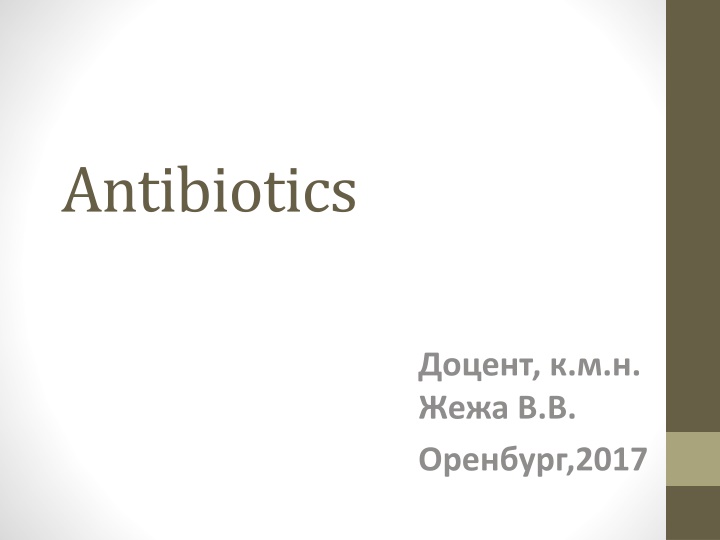
A Comprehensive Guide to Antibiotics Classification and Usage
Explore the diverse world of antibiotics, from sulfonamides to glycopeptides, and learn about their chemical structures and applications. This comprehensive guide covers a wide range of antibiotics such as penicillins, tetracyclines, aminoglycosides, and more, providing valuable insights into their mechanisms of action and importance in medical treatment.
Download Presentation

Please find below an Image/Link to download the presentation.
The content on the website is provided AS IS for your information and personal use only. It may not be sold, licensed, or shared on other websites without obtaining consent from the author. If you encounter any issues during the download, it is possible that the publisher has removed the file from their server.
You are allowed to download the files provided on this website for personal or commercial use, subject to the condition that they are used lawfully. All files are the property of their respective owners.
The content on the website is provided AS IS for your information and personal use only. It may not be sold, licensed, or shared on other websites without obtaining consent from the author.
E N D
Presentation Transcript
Antibiotics , . . . . . ,2017
Classification A. Chemical structure
/1.Suffonamides and related drugs: Sulfadiazine and others, Sulfones-Dapsone (DDS),Paraaminosalicylic acid (PAS)
,2.Diaminopyrimidines: Trimethoprim, Pyrimethamine
,3.Quinalones: Nalidixic acid, Norfloxacin,Ciprofloxacin, Gatifloxacin, etc.
,4. -Lactam antibiotics: Penicillins, Cephalosporins, Monobactams, Carbapenems.
, 5. Tetracyclines: Oxytetracycline, Doxycycline, etc.
,6.Nitrobenzene derivative: Chloramphenicol.
, 7.Aminoglycosides: Streptomycin, Gentamicin, Amikacin, Neomycin, etc.
0 , 8.Macrolide antibiotics: Erythromycin, Clarithromycin, Azithromycin, etc.
,9.Lincosamide antibiotics: Lincomycin,Clindamycin
,10. Glycopeptide antibiotics: Vancomycin,Teicoplanin.
,11. Polypeptide antibiotics: Polymyxin-M, Colis- tin, Bacitracin, Tyrothricin.
,12. Nitrofuran derivatives: Nitrofurantoin, Furazolidone.
,13. Polyene antibiotics: Nystatin, Amphotericin-B, Hamycin
, B. Mechanism of action
1. Inhibit cell wall synthesis
2. Cause leakage from cell membranes:
3. Interfere with DNA synthesis: Quinolones nitrofurans
5. Interfere with intermediary metabolism
C. Spectrum of activity Narrow-spectrum: Gram positive Penicillin Streptomycin Erythromycin Lincomycin Gram negative Polymyxin-M
,Broad-spectrum(gram- positive, gram- negative) Tetracyclines Chloramphenicol Cephalosporins Aminoglycosides
, Penicillin was the first antibiotic to be used clinically in 1941. It is a miracle that the least toxic drug of its kind was the first to be discovered. It was originally obtained from the fungus Penicillium notatum .
A.Flemming(1881- 1955) English microbiologist. Discovered the antibiotic penicillin(1929).Durin g the period between 1940-1944 H.W. Florey and E.H.Chain, working in the Great Britain, created the first penicillin preparation for the use in the medical practice. All three of them were awarded the Nobel Prize ,
Chemistry and properties The penicillin nucleus consists of fused thiazolidine and -lactam rings to which side chains are attached through an amide linkage.
lassification The method of obtaining 1.Natural penicillini -benzylpenicillin -sodium salt -potassium salt
,2. Semi-synthetic penicillin -oxacillin -ampicillin -methicillin -amoxicillin
Mechanism of action All -lactam antibiotics interfere with the synthesis of bacterial cell wall. The bacteria synthesize UDP-N- acetylmuramic acid pentapeptide, and UDP-N- acetyl glucosamine.
,The bacterial cell wall consists of murein mucopeptide (contains N- acetylglucosamine, N- acetylmuramic acid and peptide chains including certain L- and D- aminoacids). Due to this, the substances inhibiting its synthesis,have an apparent antimicrobial effect and do not really affect the macroorganism cells.
Type of action. Primarily bactericidal Penicillins Aminoglycosides Polypeptides Rifampin Isoniazid Pyrazinamide Cephalosporins Vancomycin Nalidixic acid Ciprofloxacin Metronidazole Cotrimoxazole
Spectrum of penicillins activity is limited.
, The microorganisms sensitive to benzylpenicillin are gram- positive cocci (non penicillinase-producing staphylococci, streptococci,pneumococci),gr am-negative cocci (meningococci,gonococci).
,One of the aminopenicillins, is ampicillin. It affects both gram- positive and gram- negative microorganisms (salmonellas, schigellas, some strains of proteus, Escherichia coli). A complex preparation ampiox (ampicillin with oxacillin) is also available.
Penicillin use for 1. Streptococcal infections . Like pharyngitis,otitis media, scarlet fever, rheumatic fever respond to ordinary doses of PnG given for 7-10 days. For subacute bacterial endocarditis (SABE) caused by Strep. viridans or faecalis high doses (10-20 MU i.v. daily) along with gentamicin given for 2-6 weeks is needed.
,2. Pneumococcal infections. PnG is not used now for empirical therapy of pneumococcal (lobar) pneumonia and meningitis because many strains have become highly penicillin resistant. However, PnG 3-6 MU i.v. every 6 hours is the drug of choice if organism is sensitive.
,3. Meningococcal infections . are still mostly responsive; meningitis and other infections may be treated with intravenous injection of high doses.
, 4. Gonorrhoea. PnG has become unreliable for treatment of gonorrhoea due to spread of resistant strains.
,5. Syphilis . T. pallidum has not shown any resistance and PnG is the drug of choice. Early and latent syphilis is treated either with daily injection of 1.2 MU of procaine penicillin for 10 days or with 1-3 weekly doses of 2.4 MU benzathine penicillin. For late syphilis, benzathine penicillin 2.4 MU weekly for 4 weeks is recommended. Cardiovascular and neurosyphilis requires 5 MU i.m. 6 hourly of sod. PnG. For 2 weeks followed by the above regimen. Leptospirosis: PnG 1.5 MU injected i.v. 6 hourly for 7 days is curative.
side effects 1.Allergic effect(itching, anaphylactic shock) 2.Bacteriolysis 3.Superinfections
